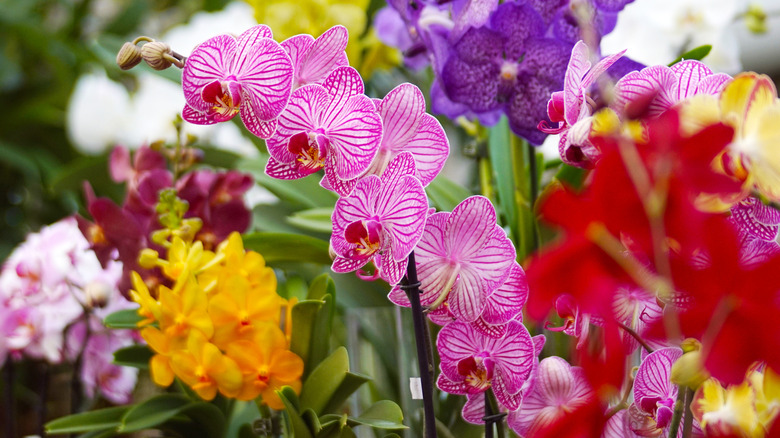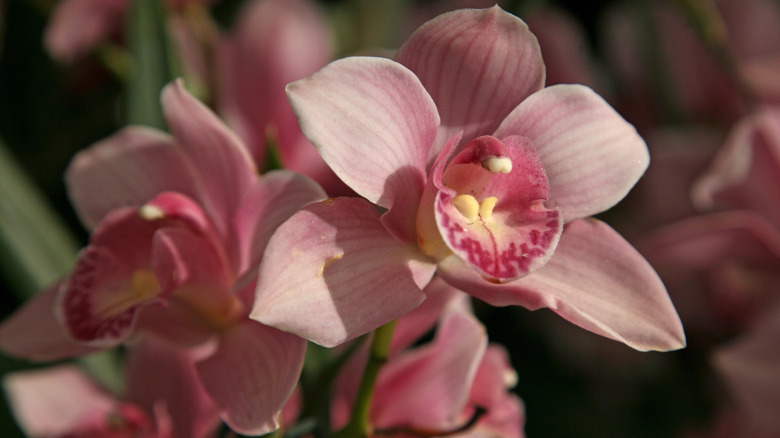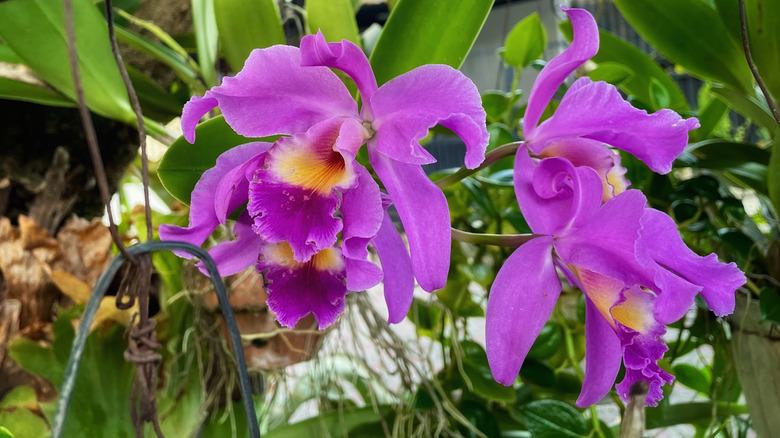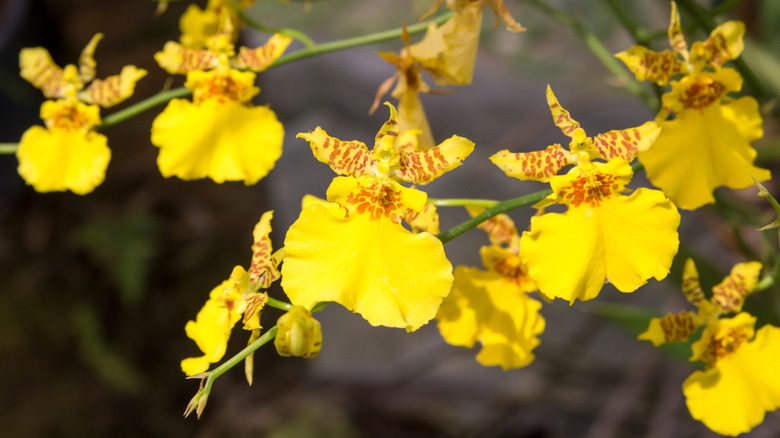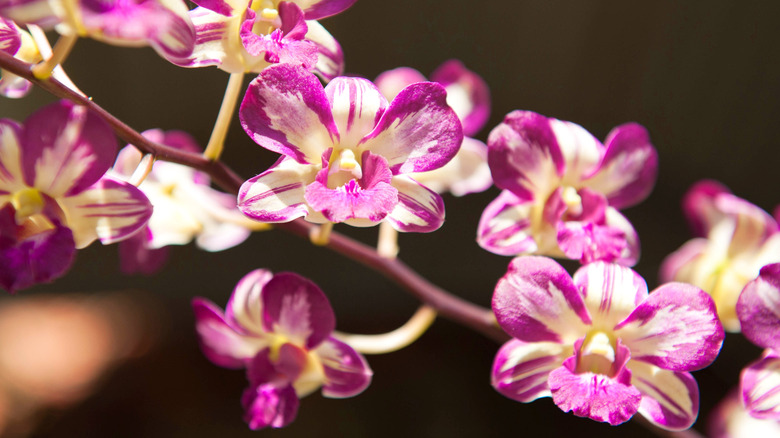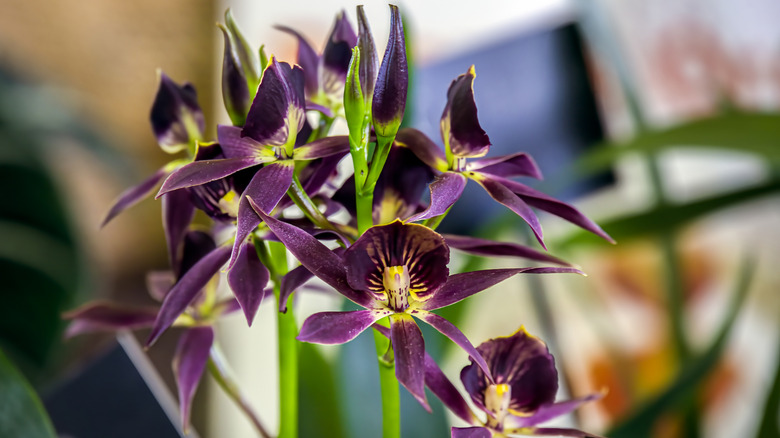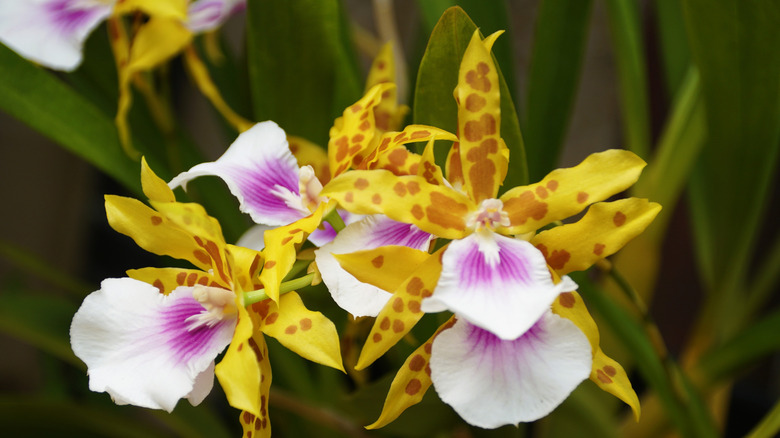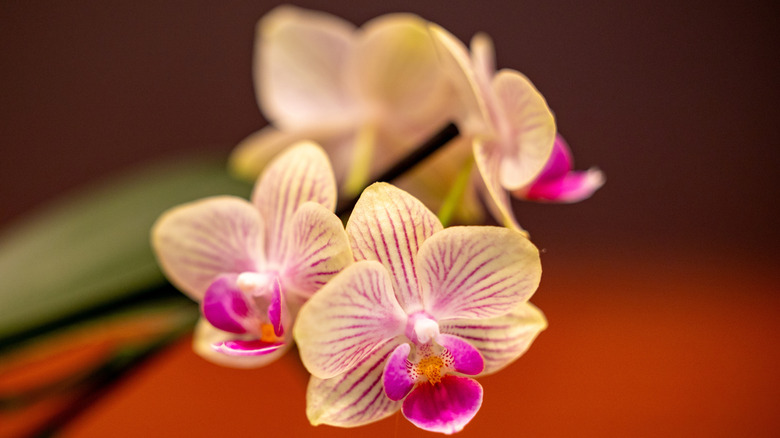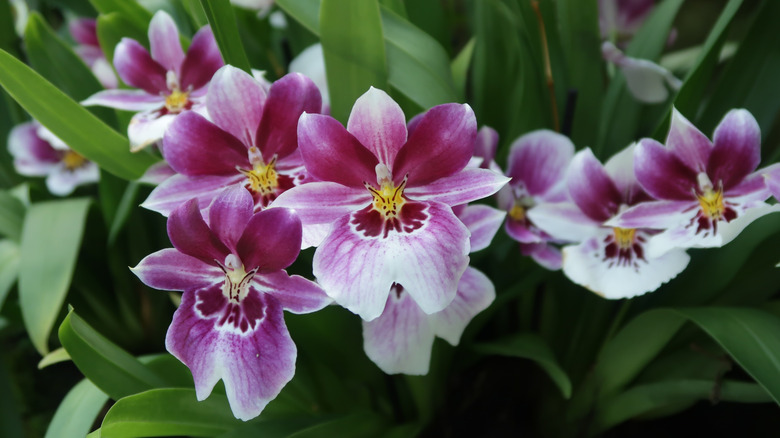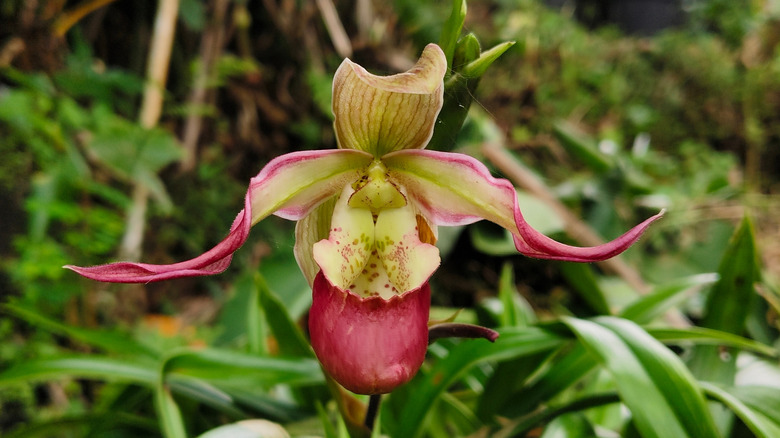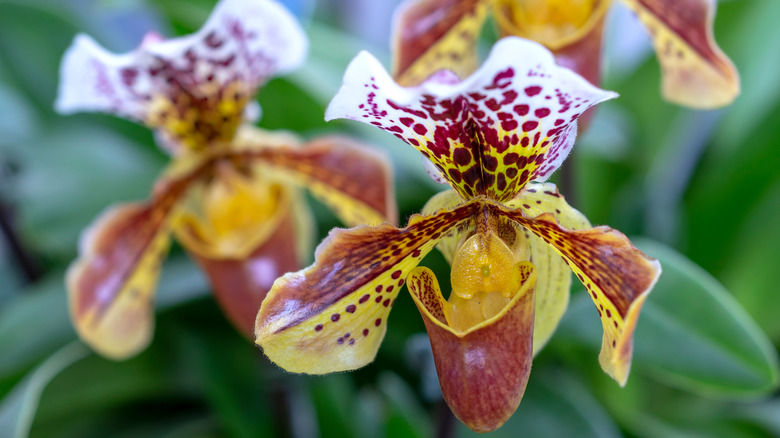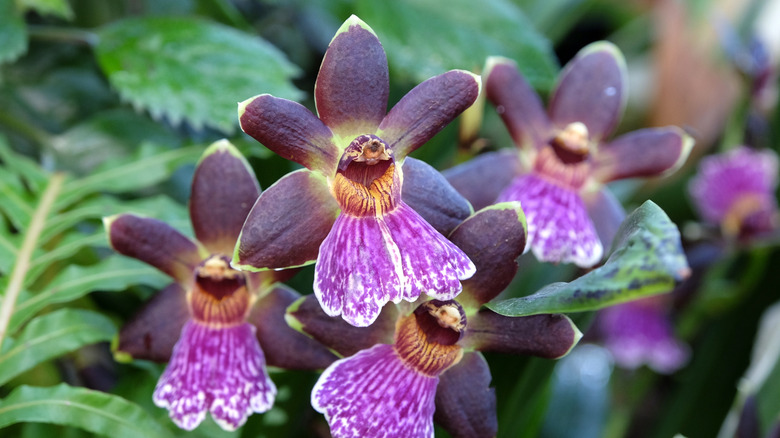13 Of The Prettiest Orchid Varieties You Could Ever Grow
It's no wonder orchids are prized for their beautiful flowers. The very large Orchidaceae plant family is brimming with so many gorgeous examples, we could make dozens of lists of the prettiest varieties, each with completely different options. But there's a big difference between being able to admire a lovely plant and having the resources and skillset to keep it alive. That's why this selection presents some of the most attractive varieties you can grow at home, with lots of options for beginners. Moth (Phalaenopsis), corsage (Cattleya), and dancing lady orchids (Oncidium) are all stunning possibilities that you can easily find to purchase and care for as houseplants without too much effort.
If you're searching for a plant to make your own, you'll want to make sure to choose the right type of orchid — one that matches not just your aesthetic preferences, but also the growing conditions you can supply in your home, such as light and humidity. Temperature is also important, with different orchid species preferring conditions that are cool (50 to 80 degrees Fahrenheit), moderate (55 to 85 degrees), or warm (60 to 90 degrees). Also, be realistic about the amount of care you're able to provide. Some of these beautiful species don't mind drying out between waterings, while others must have constantly moist soil. For the following selections, you'll learn what makes these plants' blooms so pretty, as well as their basic care needs in case you're thinking of bringing one of these beauties home.
Boat orchids
Boat orchids (Cymbidium) are beginner-friendly species that prefer cool temperatures. Once a year, they come into their own as one of the plants that flower beautifully indoors during winter, spring, or summer, depending on the species. Their long-lasting, showy blooms usually appear in shades of white, pink, green, orange, or yellow, and have prominent, three-lobed lips. Some Cymbidium types have lips of a color that contrasts with their petals and sepals. These houseplants prefer moist conditions and bright, indirect light, and can be grown in plastic or clay pots.
Corsage orchids
Known as corsage orchids, beginner-friendly Cattleyas have stunning blooms. Thanks to their easy care needs, Cattleya houseplants are perfect for big flowers and sweet smells. These lovelies appear in a multitude of hues, including purple, orange, and burgundy. The lips of their blooms are often ruffled and contrasted in color with the rest of the blossom. As for light, aim for at least four hours of direct sunlight, preferably in the morning when the sun is gentle. Cattleyas prefer moderate temperatures and well-draining clay pots; water as soon as the potting medium dries out.
Dancing lady orchids
Dancing lady orchids (Oncidium) are easy-to-grow plants that bear brown, copper, and yellow blooms. Rather than big blooms, these houseplants produce sprays of numerous small flowers. They thrive in cool temperatures with one to five hours of direct sun each day and prefer to stay slightly moist between waterings. If you've been hoping to keep a mounted epiphyte, these make good choices, though they can also be cultivated in pots. Oncidiums can blossom up to three times a year, making them even more attractive to those seeking to surround themselves with pretty blossoms indoors.
Cane orchids
Dendrobium species, commonly known as cane orchids, are another type that grows well as houseplants. These include some that are beginner-friendly, such as the Cooktown orchid (Dendrobium bigibbum). The lipped flowers of these varieties are born singly or in clusters, and in a wide range of colors, including purple, orange, and brown. Many types of Dendrobiums have a spur on the back of the bloom, like columbine blossoms. Moist soil and bright indirect light are best for these species. They also need relatively small pots and intermediate temperatures.
Cockleshell orchids
Cockleshell orchids (Encyclia) bear pretty sprays of blooms in purple, brown, and green. Their flowers stand out because the lip is upside down compared to other orchid species. These striking species aren't demanding, making them low-maintenance houseplants. They require moderate to warm temperatures and a few hours of bright morning sun. Encyclias should be potted in clay pots or wooden baskets, and need to be allowed to dry between waterings.
Laelia
Laelia species are known for their showy blooms in hues of white, pink, and purple, with tubular lips. Some of them are beginner-friendly, thanks to their forgiving care requirements. They prefer very bright, indirect light, intermediate temperatures, and potting media that dries out between waterings. They can be grown in pots or mounted — though if mounted, they'll need to be watered daily.
Miltonia orchids
Miltonia orchids make for ideal houseplants that will make your home smell amazing. These plants have pointy-petaled blooms, usually in yellow, brown, white, and purple. Miltonia species prefer warm conditions and bright, indirect light. You should let the potting medium come close to drying out in between waterings. These plants can be mounted on pieces of wood or cork instead of being grown in pots, but will require more frequent watering and higher humidity.
Moth orchids
Moth orchids are the orchids most widely grown as houseplants, and they are excellent for beginners. These plants bear pretty, long-lasting flowers that reach 3 to 6 inches wide and resemble butterflies or moths, which inspires their common name. Phalaenopsis blooms tend to come in hues of pink, purple, white, or yellow. They thrive in warm temperatures, dappled light or shade, and a potting medium that remains moist. While Phalaenopsis are typically potted in transparent plastic pots, they can also be cultivated in coir-lined baskets, a striking way to hang orchid flowers for a brand new look.
Miltoniopsis orchids
Pansy orchids (Miltoniopsis) have pretty flowers that look like pansy blooms, typically in shades of pink, red, or purple. Some are white with large, symmetrical yellow and magenta spots, while others have contrasting veins and brightly colored centers. Though they are gorgeous to gaze on, pansy orchids provide a challenge to care for at home since they prefer a combination of cool temperatures and high humidity. If you decide to give one a try, provide your houseplant with bright, indirect light and don't allow its potting medium to dry out. Miltoniopsis can be grown in pots or mounted.
Lady's slipper orchids
Known by the common name lady's slipper orchid, Phragmipedium species offer beautiful, colorful flowers with slipper-shaped lips. Their blooms come in shades of red, pink, orange, green, and yellow, and some have contrasting veins. While they can be kept as houseplants, they are best for more experienced growers since they require very bright light but don't tolerate hot temperatures or direct sun well. Pot lady's slipper orchids in snug, plastic pots, and keep the growing medium moist.
Slipper orchids
Slipper orchids (Paphiopedilum) bear gorgeous flowers with distinctive, pouch-shaped lips, similar to lady's slipper orchids, and colorful patterns. Their long-lasting blooms come in a range of hues, including copper, burgundy, green, and pink, often with stripes or spots. These easy-to-grow houseplants prefer a few hours of direct morning sunlight or filtered afternoon light. They like moist conditions, so don't allow them to dry out between waterings, and keep them potted snuggly. Paphiopedilum varieties that have mottled leaves need moderate temperatures, while those with green foliage prefer cool temperatures.
Vanda orchids
The Vanda genus is prized for its blue-colored flowers, though these fragrant, long-lasting blooms come in other colors as well. These houseplants are best for those up for a challenge since they are very large and need humidity levels over 65%. Vandas also need warm temperatures and very bright light, so they typically require a south-facing window, and they need to dry between waterings. Those with greenhouses will have the best luck with these plants. As for containers, they can be mounted, cultivated in pots or baskets, or simply hung without any growing medium at all.
Zygopetalum orchids
Sometimes referred to as zygos, Zygopetalum orchids are among the types of orchids that make the easiest houseplants. Their sprays of multicolored and fragrant blooms frequently appear in fascinating colorations of green with burgundy blotches, combined with eye-catching purple and white lips. Provide these plants with bright, indirect light and don't allow the growing medium to dry out. Zygopetalum species need cool temperatures to flower, and unlike many Orchidaceae houseplants, they prefer large pots.
